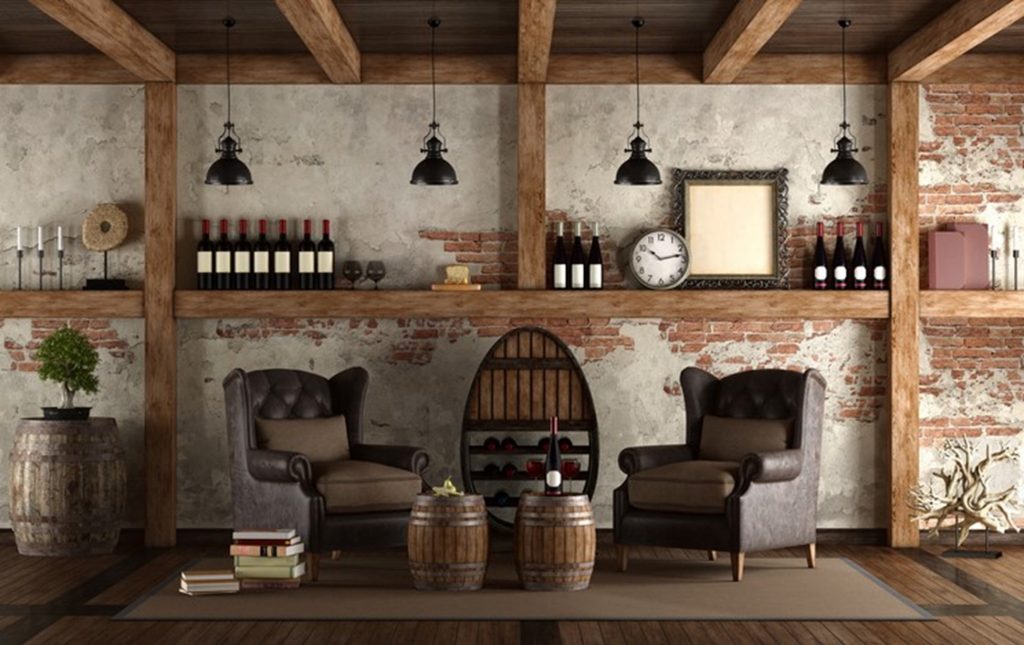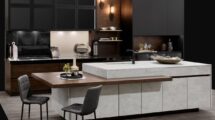Originally posted on Porch.com

For those who appreciate a good glass of wine, having the right storage makes pouring a nice glass of vino easy. A wine cellar will provide you with a place to organize your favorite bottles for easy access and stylish organization. Before wine lovers can celebrate this new addition, it’s important to decide what type of cellar you want. Whether it’s a secret stash of wine under the kitchen counters or a custom wine bar, you need to pick a spot where your wine will be stored. Think about the location, functionality, and aesthetics of your new wine cellar to help you design the ultimate spot. Read on for some tips that will help you create the perfect wine cellar at home.
Location and Other Considerations
Once you decide that a wine cellar is right for you, there are a few key things to consider. First, think about the location of your wine cellar and how much space it will take up in your home. If you have a basement, this can be a perfect spot for a new wine cellar. If you’re limited on space, you’ll need to find a designated part of your home where you can store a few bottles. A separate part of your kitchen can be a perfect place for a small wine cellar. You can even use the space under a staircase for unique wine storage. Make sure you take the location into consideration and choose the coolest area of your home or an area with higher levels of humidity. If the new wine cellar will be a major addition to your home, take the scope of the project into account. If you’re adding onto your home, think about structural changes like installing soffits and wall studs and putting up new drywall which can be costly and time-consuming.
Things to Consider Before You Build
Once you’re ready to build your wine cellar, there are a lot of crucial things to examine before you commit. Here are some key considerations to think about before you start designing your new cellar:
- How will you use the wine cellar? Will it be a place where you can entertain friends or just a storage space for your favorite wines? Make sure you declutter the space and clean it thoroughly before you work on adding new elements to the structure.
- Understand how to store and maintain your wine properly. Without the right storage conditions, wine can go bad which means your treasured bottle of vintage red wine could be wasted.
- Look into adding specific components like the right insulation, a vapor or moisture barrier, and find ways to ensure that your wine cellar has an airtight seal.
- Think about the materials you plan to use for your wine cellar. Glass may look nice, but it’s not a good insulator. If you have your heart set on a glass door, make sure it’s double glazed or that it features an argon-filled portion between two panes to keep the room insulated. Concrete is often used for basement walls, but it will need additional insulation if you plan to store wine there. Use plywood to cover existing walls or to build new walls since it can withstand moisture better than drywall.
- Invest in a good, high-quality cooling unit to keep the temperature at an optimum level. While this may cost you a bit more upfront, it’s wise to invest in something high-quality to save you money in the long run. Basements tend to be extremely hot without the right cooling equipment in place.
- You can build your own custom wine rack or choose a prebuilt rack that will accommodate your desired number of bottles.
- Wine bottles come in a variety of shapes and sizes, so don’t forget to install racks or shelving that are adjustable or that feature different designs to fit different bottles.
- Make sure you plan your budget in advance and try not to go over your limit. Talk to several contractors and get a few estimates if you don’t think you can stay within your budget by doing things DIY.
Maintaining Your Wine Cellar
While you definitely want your new wine cellar to look fabulous with some chic décor, it’s also important that you maintain it, so your bottles of wine remain in good condition. Here are some tips to ensure that your wine cellar is taken care of the right way:
- The temperature and humidity levels need to be consistent for wine to stay fresh, so invest in a good digital thermometer and hygrometer. A hygrometer reads the humidity levels in the air to help you monitor the conditions in your wine cellar. Look for new products that feature wireless capabilities so you can check the status of your wine cellar from your phone.
- Keep your wine cellar clean, and don’t let dust accumulate on the bottles. If a bottle breaks or something spills, clean it up immediately to prevent pests from making your wine cellar their home.
- Install some soft lighting in your wine cellar so you can see everything clearly. Recessed lighting is a good choice for basements since they won’t take up too much space. Choose lightbulbs that emit a soft, warm light and avoid harsh ultra-bright lights that could compromise the integrity and flavor of your wine. LED lights are a good option since they don’t produce a lot of heat.
- If possible, choose an area of your home that doesn’t have direct sunlight. If your wine cellar has windows, make sure you cover them with a good set of blinds or some quality room darkening curtains.
Wine Storage Guide
Maintaining your wine cellar is important, but you also want to make sure that your wine is stored properly.
- If wine is exposed to sunlight, the amino acids can oxidize and change the flavor. Keep your wine in a cool, dark place out of direct sunlight and away from fluorescent lights. White wine is especially vulnerable to sunlight since most wineries bottle it in clear glass. Smell your wine when you open it and look for any unpleasant smells which could mean that it has already become oxidized.
- Store wine bottles with corks on their side instead of upright. This will slow down the oxidation process and keep the cork moist, so it doesn’t rot or fall apart. You can store twist-top bottles upright, but ideally, all wine should be laid in racks horizontally.
- Once you open a bottle of wine, it doesn’t typically last more than a week. White wine and rose can last about five to seven days in the fridge if it’s re-corked. Red wine should last about three to five days if you replace the cork and store it in a cool, dark place.
- You may be surprised to learn that wine can actually absorb strong odors. If wine is exposed to things like onions or even the trash can in your kitchen, those odors can permeate the cork and get into the wine over time. Avoid exposing your wine to strong odors by keeping it separated from everything else in your home. Adding a door with an airtight seal will help to keep unpleasant odors from seeping into your wine cellar.
- Your wine racks can be made of anything you like including solid wood or metal. It’s easy to make DIY wine racks yourself if you want to save money. You can even choose your favorite type of wood and finish it in your desired color for a custom look. Just make sure you make enough racks to hold plenty of bottles with room to spare.
Store and Care for Your Wine in Style
A custom wine cellar is a great way to keep your wine safely stored. Look for some unique inspiration online to add décor and lighting to this space, especially if you plan to use it for entertaining or tastings. You can create your wine cellar DIY or hire a contractor if you’re planning to make major changes to your home. If you’re just choosing a small space like an area under a staircase, creating your own wine cellar DIY should be a fairly easy process. Make sure you follow these tips about how to store your wine properly so that it lasts for many years until you’re ready to open it.
Creating a custom wine cellar in your home is a great way to enjoy your favorite bottles of wine while keeping them protected. Look for unique design ideas and inspiration that will help you add a personal touch to your storage space. Keep wine bottles out of direct sunlight and check the air temperature and humidity levels to ensure they’re always at a consistent level. With these simple tips, your new wine cellar is sure to be the envy of the neighborhood.






